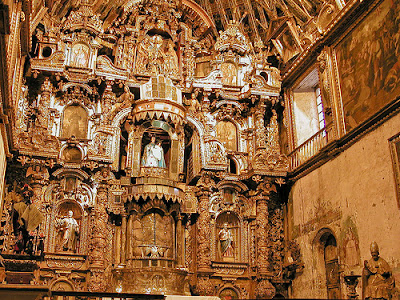Discover the beauty of the Galapagos Islands and the amazing history and culture of Machu Picchu
Monday, March 14, 2011
Historic Lima
Sunday, March 13, 2011
Huaca Pucllana
Thursday, March 10, 2011
Plaza de Toros de Acho
Swimming with Sea Lions
March is the warmest time of year in the Galapagos Islands. There is no better way to cool off during your Galapagos Cruise than to go swimming with sea lions. Galapagos Sea Lions are fun loving animals enjoy a came of underwater tag with passing swimmers.
Friday, March 4, 2011
Sistene Chapel of the Andes - The Church at Andahuaylillas
The small town of Andahuaylillas is on the main road that connects Cusco with Lake Titicaca. What may first appear just as a typical town is well worth the visit. There town has a main square with a modest church that appears as many others throughout the region it was built from adobe on the site of a former Incan palace a scenario seen elsewhere in Peru.
Yet as you walk through the church's doors you will discover at once why the San Pedro Church is called the ‘Sistine Chapel of the Andes’, the church's interior is an artistic masterpiece of carved woods, paintings, and frescos.
As you enter the church there are incredible contrasting frescos on either side of the main door on one side is the road to heaven and on the other the road to hell. As your eyes rise up to the ceiling you will see the ceiling is decorated in a floral patterns accented by gold leaf. The church's walls are blanketed with inspiring paintings from the bible framed in gold creating a pathway to the front of the church and the 24 karat gold leaf alter.
Thursday, March 3, 2011
Choquequirao
Choquequirao name in Quechua is the Cradle of God, located above the Apurimac River a two day hike outside of Cusco. The ruins at are often considered the Sacred Sister to Machu Picchu like Machu Picchu it was first rediscovered by Hiram Bingham as well as its similar architecture and layout. The citadel has a temple, terraces, main plaza, and administrative buildings, living quarters for the aristocrats, water channels, aqueducts and springs. However unlike Machu Picchu, Choquequirao was largely forgotten again by the outside world until 1993 when the Peruvian Government began clearing the site. Choquequirao is substantially larger than Machu Picchu but to date only about 1/3 of it has been uncovered the rest remains covered by the dense jungle.The most recognizable feature at Choquequirao are the llama terraces where more than two dozen llamas are set into the stone terraces.
Wednesday, March 2, 2011
Galapagos Dove
Galapagos Doves are endemic to the Galapagos Islands. These tame birds can be found throughout the archipelago in the arid lowlands of the islands. Early March is when the majority of Galapagos Doves are born in the islands.
Subscribe to:
Comments (Atom)



